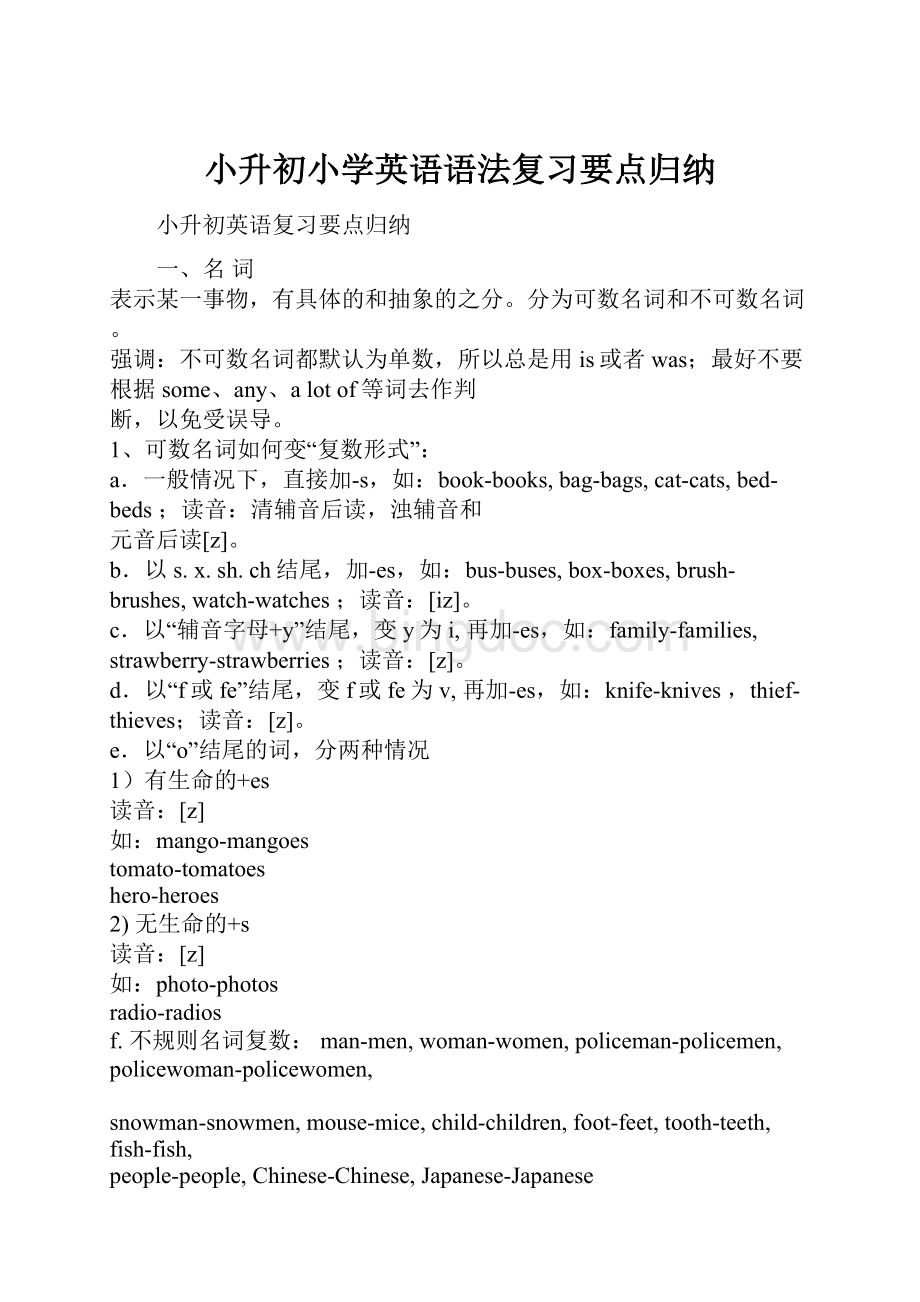小升初小学英语语法复习要点归纳.docx
《小升初小学英语语法复习要点归纳.docx》由会员分享,可在线阅读,更多相关《小升初小学英语语法复习要点归纳.docx(45页珍藏版)》请在冰点文库上搜索。

小升初小学英语语法复习要点归纳
小升初英语复习要点归纳
一、名词
表示某一事物,有具体的和抽象的之分。
分为可数名词和不可数名词。
强调:
不可数名词都默认为单数,所以总是用is或者was;最好不要根据some、any、alotof等词去作判
断,以免受误导。
1、可数名词如何变“复数形式”:
a.一般情况下,直接加-s,如:
book-books,bag-bags,cat-cats,bed-beds;读音:
清辅音后读,浊辅音和
元音后读[z]。
b.以s.x.sh.ch结尾,加-es,如:
bus-buses,box-boxes,brush-brushes,watch-watches;读音:
[iz]。
c.以“辅音字母+y”结尾,变y为i,再加-es,如:
family-families,strawberry-strawberries;读音:
[z]。
d.以“f或fe”结尾,变f或fe为v,再加-es,如:
knife-knives,thief-thieves;读音:
[z]。
e.以“o”结尾的词,分两种情况
1)有生命的+es
读音:
[z]
如:
mango-mangoes
tomato-tomatoes
hero-heroes
2)无生命的+s
读音:
[z]
如:
photo-photos
radio-radios
f.不规则名词复数:
man-men,woman-women,policeman-policemen,policewoman-policewomen,
snowman-snowmen,mouse-mice,child-children,foot-feet,tooth-teeth,fish-fish,
people-people,Chinese-Chinese,Japanese-Japanese
2、不可数名词没有复数。
如果要计算不可数名词所表达的数量,就得在数词和不可数名词之间加上“量
词+of”。
例如:
aglassofwater,apieceofpaper,abottleofjuice
判断步骤:
↗如是am、is或was→原形
读句子→读该单词→认识该单词→理解意思→看be动词
↘如是are或were→加s或es
练一练:
1、写出下列各词的复数。
I_________ him_________ this_______ her______ watch_______ mango_______child_______photo________diary______ day________ foot________dress________tooth_______
sheep______ box_______ strawberry_____thief_______engineer______peach______
sandwich______ man______ woman_______ leaf_______ people_______
2、用所给名词的正确形式填空。
(1)Aretheretwo(box)onthetable?
(2)Icanseesome(people)inthecinema.
(3)Howmany(day)arethereinaweek?
(4)Here’refive(bottle)of (juice)foryou.
(5)This(violin)ishers.Those(grape)areoverthere.
二、冠 词
冠词是一种虚词,不能独立使用,通常放在名词的前面,分为“不定冠词”和“定冠词”两种。
1、不定冠词:
a、an。
用在单数名词前,表示“一个,一件……”。
an用在以元音“音素”开头的单词前。
如:
ane-mail,anorange,anoldman,anEnglishwatch,anhour…
2、定冠词:
the。
用在单数或者复数名词前。
the没有具体意思,有时翻译为这、那。
它的基本用法:
(1)用来表示特指某(些)人或某(些)事物。
如:
Themaponthewallisnew.
(2)表示说话者双方都知道的人或事物。
如:
Lookatthepicture,please.
(3)表示再次提到前面谈过的人或事物。
如:
Thisisastamp.Thestampisbeautiful.
(4)用在表示世界上独一无二的事物前。
如:
thesun太阳 themoon月亮 theearth地球
(5)用在由普通名词构成的专有名词前。
如:
theGreatWall长城
(6)用在江河、湖海等专有名词前。
如:
theChangjiangRiver长江
(7)此外,序数词、形容词最高级、乐器名称等词前面和一些习惯用语中一般都用定冠词the。
如:
thefirstday,thebestboy,playthepiano,inthesameclass
确定用a、an还是the时可根据汉语意思。
练一练:
1、用a或an填空。
____“U” ____ice-cream
____ goalkeeper ____teapot ____apple
____office
____Englishbook
____umbrella
____unit
____hour
2、根据需要,填写冠词a,an或the。
(1)Whois____girlbehind____tree?
(2)____oldmanhastwochildren,____sonand____daughter.
(3)Thisis ____orange. ____orangeisLucy’s.
(4)Helikesplaying____guitar.Wehave____samehobby.
(5)Weallhad____goodtimelastSunday.
(6)Shewantstobe____doctor.
三,数词
我们学过两类:
基数词和序数词。
基数用于表示数量多少,而基数词用于表示次序,常在日期中出现。
区别:
基数词前面没有“the”;序数词前一定要有“the”。
1、超过二十以上的两位数需要在个位和十位之间加上“-”。
如:
21 twenty-one
2、三位数以上的则需要在百位数后再加上and。
如:
101 a/onehundredandone
3、用基数词来修饰可数名词时,一定别忘了它的复数形式。
如:
十八个男孩 eighteenboys
4、用基数词修饰不可数名词时,如是复数,变它的量词为复数。
如:
两碗米饭 twobowlsofrice
5、序数词一般加“th”,特殊的有:
first,second,third,fifth,eighth,ninth,twelfth以及二十及二
十以外的整十:
twentieth,thirtieth,fortieth…“第几十几”:
前面整十不变,后面“几”改为序
数词。
如:
88 eighty-eighth
练一练:
1、请翻译下列短语。
(1)60名学生
(2)15本英语书
(3)九杯凉水
(4)4个孩子
(5)12月31
(6)6月2日
(7)第九周
(8)40年前
(9)11+7
(10)上学第一天
2、把下列基数词改成序数词。
one---
two---
three---
nine---
fourteen--- twenty--- thirty-five--- eighty-one
四、代 词
代词有两种:
人称代词和物主代词。
1、人称代词分为:
第一、第二、第三人称,且有单复数之分。
2、人称代词的主格在句中做主语,一般用在动词前(疑问句除外);宾格在句中做宾语,多
用于动词、介词后。
3、形容词性物主代词起形容词的作用,后面一定要跟名词,表示该名词是属于谁的。
4、名词性物主代词=形容词性物主代词+名词。
如:
Thisismybag.=Thisismine. Thatisherruler.=Thatishers.
一般看后面有没有名词,如有,就用形容词性物主代词;如无,就用名词性物主代词。
请牢记下表:
二、代词
人称代词
主格
宾格
形容词性物主代词(短)
名词性物主代词(长)
我
I
me
my
mine
你
you
you
your
yours
他
he
him
his
his
她
she
her
her
hers
我们
we
us
our
ours
你们
ou
you
your
yours
他们
they
them
their
theirs
口诀:
主格应该作主语,放在句子的开头;
宾格应该作宾语,放在动词介词后;
形容词性的物主代词不能单独用,必须接名词或其他词;
名词性的物主代词,单独使用就可以。
1、按要求写出相应人称代词。
I(宾格)_______ she(形容词性物主代词)_______
we(名词性物主代词)_______
he(复数)_______ us(单数)_______ theirs(主格)_______its(宾格)_______
2、用所给词的适当形式填空。
1)Thatisnot_________kite.Thatkiteisverysmall,but_________isverybig.(I)
2)Thedressis_________.Giveitto_________.(she)
3)Isthis_________watch?
(you)No,it’snot_________.(I)
4)_________ismybrother.________nameisJack.Look!
Thosestampsare_________.(he)
5)_________dressesarered.(we)Whatcolourare_________?
(you)
6)Show_________yourkite,OK?
(they)
7)Ihaveabeautifulcat._________nameisMimi.Thesecakesare_________.(it)
8)Arethese________tickets?
No,________arenot_________.________aren’there.(they)
9)Shall_________havealookatthatclassroom?
Thatis_________classroom.(we)
10)_________ismyaunt.Doyouknow_________job?
_________isanurse.(she)
11)Whereare_________?
Ican’tfind_________.Let’scall_________parents.(they)
12)Don’ttouch_________._________isnotacat,_________isatiger!
(it)
13)_________sisterisill.Pleasegoandsee_________.(she)
14)Thegirlbehind_________isourfriend.(she)
五、形容词、副词
1、形容词表示某一事物或人的特征,副词表示某一动作的特征。
形容词和副词有三种形式:
原形、比较
级、最高级。
比较级:
+er 最高级:
the…+est
两个重要特征:
as……as中间一定用原形,than的前面一定要+er。
2、形容词、副词比较级的规则变化如下:
(1)一般直接+er。
如:
tall-taller,fast-faster 单音节词如果以-e结尾,只加-r。
如:
late-later
(2)重读闭音节词如末尾只有一个辅音字母,须双写这个字母,再加-er。
如:
big-bigger,fat-fatter
(3)以辅音字母加-y结尾的词,变y为i,再加-er。
如:
heavy-heavier,early-earlier
(4)双音节和多音节词的比较级应在原级前加more构成。
如:
beautiful-morebeautiful,
careful-morecareful,quietly-morequietly,interesting-moreinteresting
(5)有些不规则变化的,须逐一加以记忆。
如:
good/well–better,bad/ill–worse,many/much–more,far–farther/further,old–older/elder…
练一练:
1、写出下列形容词、副词的比较级。
big
good
long
tall
old
short
thin
heavy
young
fat
light
strong
high
far
low
early
late
well
fast
slow
2、用括号内所给单词的适当形式填空。
1)Icanswimas_______(fast)asthefish,Ithink.
2)Look!
Hishandsare_______ (big)thanmine.
3)Ithinkyoudothesethings_______(well)thanyourclassmates.
4)Whosebagis_______(heavy),yoursormine?
5)DoesJimrunas_______(slow)asDavid?
Yes,butMikeruns_______(slow)thanthem.
6)Youhavesevenbooks,butIhave_______(many)thanyou.Ihaveten.
7)Ijump_______(far)thansomeoftheboysinmyclass.
8)I’mvery_______(thin),butshe’s_______(thin)thanme.
9)Itgets_______and_______(warm)whenspringcomeshere.
六、介 词
1、一种虚词。
不能单独作句子成分,它只有跟它后面的宾语一起构成介词短语,才能在句子中起作用。
有:
in,on,under,with,behind,about,near,before,after,for,to,up,down,from,infrontof,outof,
from…to…,atthebackof…
2、表示时间的介词有:
at,on,in。
(1)at表示“在某一个具体的时间点上”,或用在固定词组中。
如:
atten
o’clock,at9:
30a.m.,atnight,attheweekend…
(2)on表示“在某日或某日的时间段”。
如:
onFriday,onthe
firstofOctober,onMondaymorning…(3)in表示“在某一段时间(月份、季节)里”。
如:
intheafternoon,
inSeptember,insummer,in2005…
3、in一词还有其他的固定搭配,如:
inblue(穿着蓝色的衣服),inEnglish(用英语表达),takepartin(参加)。
练一练:
1、选用括号内恰当的介词填空。
1)What’sthis_______(at,on,in)English?
2)Christmasis_______(at,on,in)the25thofDecember.
3)Theman_______(with,on,in)blackisSuHai’sfather.
4)Hedoesn’tdowell _______(at,on,in)PE.
5)Lookatthosebirds _______(on,in)thetree.
6)Wearegoingtomeet _______(at,on,in)thebusstop _______(at,on,in)halfpastten.
7)Isthereacat _______(under,behind,in)thedoor?
8)Helen’swritingpaperis _______(in,infrontof)hercomputer.
9)Welive_______(at,on,in)anewhousenow.
10)Doesitoftenrain _______(at,on,in)springthere?
2、圈出下列句子中运用不恰当的介词,并将正确的答案写在横线上。
1)JimisgoodinEnglishandMaths.
2)Thefilmswereinthegroundjustnow.
3)Theyaretalkingtotheirplans.
4)HowmanystudentshavetheirbirthdaysonMay?
5)Women’sDayisatthethirdofMarch. 6)Icanjogtoschoolonthemorning.
7)Didyouwatertreesatthefarm?
8)CanyoucomeandhelpmeonmyEnglish?
9)IusuallytakephotosinSundaymorning. 10)WhatdidyoudoontheSpringFestival?
七、动 词
这里所说的动词是指各种动词总称,其中包括be动词、情态动词、助动词、行为动词(就是我们平时总说的那种动词)。
动词、名词和形容词不太容易区分,如不能一眼看出,可用如下方法:
先用“一(量词)”(如:
一个、一张等)和这个词连起来说,如说得通,一般认为是名词;说不通再用“很”去判断,就是把“很”和为个词连起来说,说得通一般就是形容词;都说不通就是动词。
(目前我们学过的,以后可能不同)(另外一些很明显的,如人称代词、数词、情态动词等一下就可以知道)
1、be动词(am,is,are,was,were)
1)am—was,is–was,are--were口诀:
我用am,你用are,is用在他她它,所有复数全用are。
2)肯定和否定句Iam(not)fromLondon.Heis(not)ateacher.Sheis(not)inthediningroom.Myhairis(not)
long.Hereyesare(not)small.
3)一般疑问句AmIaChinese?
Yes,youare.No,youaren’t.AretheyAmerican?
Yes,theyare.No,theyaren’t.
Isthecatfat?
Yes,itis.No,itisn’t.
4)be动词的否定形式:
amnot(没有缩写形式),arenot=aren’t,isnot=isn’t。
用恰当的be动词填空。
练一练:
1、用be动词的适当形式填空。
1)I______aboy.______youa